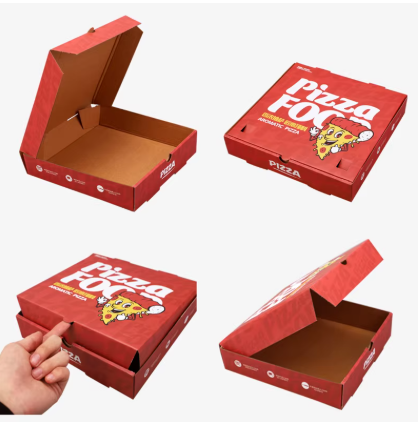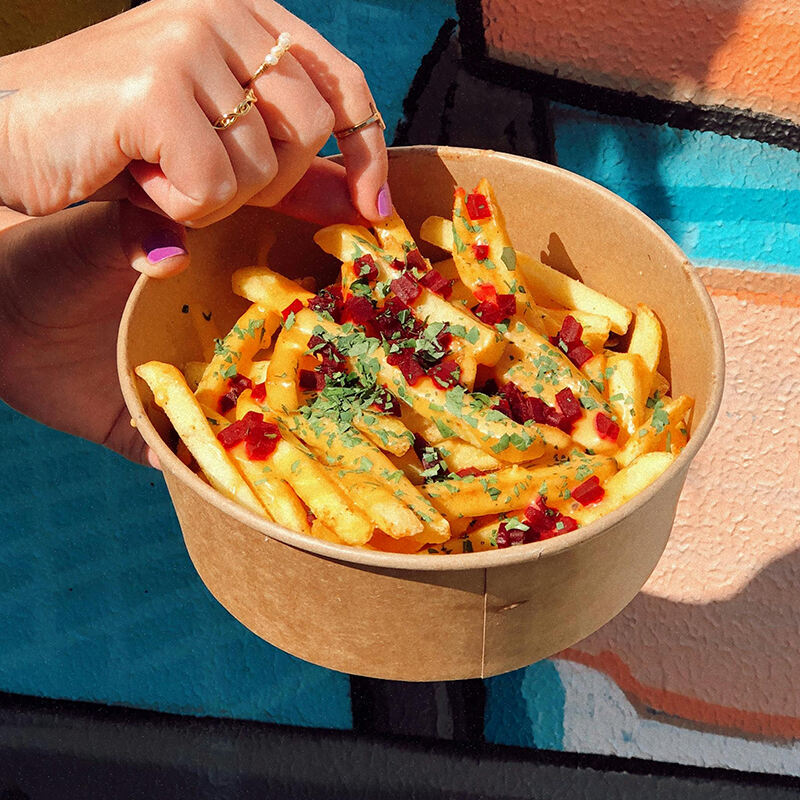Food Safety & Compliance Considerations
Is the material food-safe and certified?
Certification and food safety are of utmost importance of all fast food packaging materials. Food grade materials are crucial to food safety, and they need to meet FDA approval to guarantee consumer safety. Packaging materials, such as polyethylene and paperboard, are preferred in the industry because they are given high safety ratings. Risks are substantially higher if you don't have those certifications, as evidenced by numbers connecting noncompliant packaging with a number of health incidents. Non-food-safe materials cause contamination, threaten consumers’ health, and in turn damage brand reputation. Such certifications as FDA approval are an effective way of reducing these risks and can contribute to earning the confidence that consumers place in a product, ultimately leading the way to greater brand loyalty and credibility. The success of the brands depends on that, such as, for example, the fast food giants who guarantee that packaging is FDA certified.
Does it meet local regulations?
Understanding local state and country fast food vendor regulations is also essential in order to prevent legal and financial punishment. Each area or nation have different rules and regulation about the substances that are allowed in food packaging and they should be followed carefully. Not following these can have severe consequences, such as substantial fines and expensive product recalls. “There’s a well-known food chain that was in trouble because of non-compliant packaging,” he continues, “so there is a need to comply. To avoid these issues, it is essential for companies to place great emphasis on gaining knowledge of local laws to incorporate in their packaging strategies. Keeping pace with existing legal obligations requires ongoing research and dialogue with regulators and is an important tool for preserving market access and public confidence. Following best practices by employing compliance professionals and performing frequent audits, companies can keep up with these regulations, and thereby keep their businesses running smoothly and their brands safe in a competitive market.
Material Durability & Functional Requirements
Can it handle heat, oil, and moisture?
Suppliers of fast food packaging are particularly keen on robust and practical materials. Such materials should be resistant to heat, oil, and moisture to prevent the degradation of food during transportation and consumption. For example, polyethylene and paperboard is often used owing to its heat resistance and moisture barrier properties. These materials must pass rigorous tests to comply with standards that classify them as safe enough for contact with different kinds of foods, such as hot and greasy foods. The significance of material durability is emphasised by the following example in packaging failure statistics: Poor materials to make the package has resulted in the compromise of the quality of the product, thus indicating the need for strong packaging materials. In such environment, poor packaging durability performance can represent economic loss and brand reputation damage, making clear the key role that must be played by appropriate material selection and testing program.
What sizes and styles are offered?
The fast food packaging market also comes a broad array of sizes and styles to support different customers and menu items. Custom services can be layered as well to help brands to address specialized needs and to increase consumer satisfaction. I mean, for instance, in packaging - the variability can make a huge difference to the efficiency of how a business is operating." and this applies to things like storage space and transportation cost. The development trends of the market also see an increasing demand for certain packaging shapes and volumes depending on consumer behavior and operational requirements. Based on sales trends, specific styles and sizes sell at a premium because they are more practical or more attractive, meaning that brands must prioritize that their packaging is able to cater to such shifting demands. Finally, the ability to match packaging requirements to the needs of consumers and the business is good for overall brand perception and consumer satisfaction.
Sustainability & Cost Efficiency
Is it eco-friendly or recyclable?
The need for green packaging in the fast food sector is increasing because of the concerns for the environment and the desired choices of customers. Eco-friendly packaging, and green packaging are catching up as they pose less harm to the environment. Paperboard and biodegradable plastics are also viable candidates as they degrade under ambient conditions. The world eco-friendly food packaging market is expected to be colossal, climbing up to $319.4 billion by 2030. This trend can be explained by greater consumer demand for green products and CSR activities of the corporate sector. Environmental leadership is good business: environmental packaging attracts brand evangelists -- people who not only buy their products, but promote them to others.
What’s the unit cost and MOQ?
There are a number of considerations for choosing take away food packaging: 1. Unit cost 2. OutlineInputBorder 3. Minimum Order Quantity (MOQ) 4. Cost Effective 5. Customization 6. Environmental Impact 7. Branding opportunities 8. Storage/transportation requirement of the product. Quality and price are important factors to be balanced while buying packaging. It is a truism that the larger the order the lower tends to be the unit cost by virtue of the benefits of economy of scale. MOQs also are a determination factor for supplier selection; suppliers with reasonable MOQs are generally preferred, unless MOQ is an iron law in inventory management. Common tokuyu norms suggest that purchasing in large volume can greatly reduce cost of packaging – a critical factor since the fast food market is a very competitive one. Understanding these cost dynamics enables companies to make intelligent purchases that support financial goals.

Customization & Production Logistics
Is custom printing available?
Custom printing of boxes is an extremely effective way of establishing the brand and engaging the customer. With a distinct logo, message or appealing design, brands can really stand out in a crowded marketplace. Different printing methods as flexo printing, digital print, and offset printing, provides the opportunity for different price rates and lead times. There are benefits or drawbacks associated with each, however, making the correct choice can make a large impact on the overall look and speed of the packaging line. Tailor-made packaging solutions communicate brand identity, and result in more sales, while increasing brand loyalty. It’s this personal dimension of packaging, which turns it from just a container into a part of the product experience.
What’s the production lead time?
Lead time of production is an important perspective that can be vital to overall efficiency of supply chain especially in the case of fast food businesses. Time is at a premium and high customer turnover risks call for fast, efficient production. Holds may be due to material shortages, intensive customizations or supply-chain briefperiod. The risk is that such needs can only be fulfilled by building strong supplier relationships, as neglected product design instructions can be costly and time-consuming; valued suppliers are pivotal to meet aggressive targets for product design. Realistic lead times allow for companies to more closely align supply with demand, ensuring that they can deliver on time, while not losing money in the process. Best practices, by being proactive (eg regular communication, contingency planning), also contribute to the way in which lead times are managed, and hence positively all authoritative sources have to the management of logistics as a whole.
Supplier Reliability & Future-Proofing
Are samples available before bulk orders?
Specimens must be tested before placing bulk order to ensure quality. Samples allow us to take a look at the material quality, design integrity, and usability of packaging and can be the deciding factor in keeping testing from going down the wrong path and leading to expensive failures. For example, when it comes to disposable packaging at fast food outlets, the toughness and safety of material are extremely important to uphold customer satisfaction and the consumers’ faith in the brand. In a fast-food industry related case study, a leading chain was spared a mass product recall after defects in packaging design were exposed during sample testing and modifications were made prior to full production.
Furthermore, samples allow businesses to decide not only on the aeshetic but also on the aesthetic and practical usability that serves consumer demand. By examining these features in samples companies are able to verify the final product will perform to anticipated specifications and allow minimize the risk of surprises in bulk production. A commitment to comprehensive sampling demonstrates supplier reliability:partnerships are forged through trust backed up by a known product.
Can the supplier scale as you grow?
Choosing suppliers that can offer scaling capability is important for growth to be sustainable. A BUSINESS WHICH IS GROWING NEEDS A SUPPLY CHAIN WHICH CAN ADJUST TO THE NEW DEMANDS WITHOUT COMPROMISING THE QUALITY AND DESPATCH TIME SCALES. Otherwise, suppliers need to be not just scalable but to actually have the infrastructure to support growth. A company that has sophisticated factory building and flexible production lines is typically better positioned to serve up-and-coming fast-food businesses. One company reports that 30% of businesses faced a disruption because their scaling demand could not be met by their supplier.
To future-proof your supply chain, be on the lookout for signs a supplier has performed at scale in the past — whether that means processing massive orders for you in the past, or having plans to grow even more to match your ambitious pace. Selecting the right vendor today will enable you to keep your operation running smoothly as your business grows, allowing you to maintain a competitive advantage and provide the constant trust and stability your brand demands in the fast-paced, fast-food packaging arena.
FAQ
Q: What are food-safe and certified materials?
A: Food-safe and certified materials are those approved by regulatory bodies like the FDA. They ensure that packaging does not contaminate food and meet safety standards.
Q: Why is compliance with local regulations important?
A: Compliance prevents legal issues and financial penalties. Understanding local laws is crucial for smooth operations and avoiding product recalls.
Q: How can packaging handle heat, oil, and moisture?
A: Packaging materials like polyethylene and paperboard are durable against heat, oil, and moisture, maintaining food quality during transit.
Q: Are there eco-friendly packaging options available?
A: Yes, options like biodegradable and compostable materials are available to minimize environmental impact and cater to consumer preferences.
Q: Is custom printing an option for branding?
A: Custom printing is available, offering techniques like flexography and digital printing to enhance brand identity and customer engagement.
